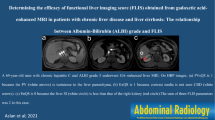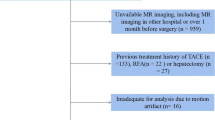Abstract
Objectives
To validate the functional liver imaging score (FLIS) for prediction of hepatic function in gadoxetic acid–enhanced MRI.
Methods
We retrospectively identified 134 patients (88 men, 46 women; mean age, 58.8 years) between January 2015 and December 2018 with the following inclusion criteria: patients diagnosed with liver cirrhosis or chronic liver disease (CLD) who underwent gadoxetic acid–enhanced MRI. Three parameters on hepatobiliary phase images were evaluated for FLIS: liver parenchymal enhancement, biliary excretion, and signal intensity of the portal vein. Patients were classified as CLD (n = 11), Child-Pugh (CP) class A (n = 87), CP B (n = 22), or CP C (n = 14). We assessed the correlation between CP score and both FLIS and its components using Spearman rank correlation. Receiver operating characteristic (ROC) curve analysis was performed to demonstrate the cutoff value of FLIS for differentiating between CP classes. The associations between patient characteristics, serum markers, FLIS, and hepatic decompensation were evaluated with Cox proportional hazard models.
Results
FLIS and three FLIS parameters showed strong to very strong correlation with CP score (r = −0.60 to 0.82). ROC curve analysis showed that FLIS ≥ 5 was the optimal cutoff for prediction of CP class A or CLD (sensitivity, 83.7%; specificity, 94.4%; area under the curve [AUC], 0.93). FLIS < 5 was independently associated with the development of first hepatic decompensation in patients with CP A (HR, 50.0; 95% confidence interval, 6.2, 400.4).
Conclusion
FLIS showed a strong correlation with hepatic function and can stratify the CP class. In addition, FLIS can help prediction for the development of first decompensation.
Key Points
• Functional liver imaging scores (FLIS) and its three parameters, derived from hepatobiliary phase image, have strong to very strong correlations with Child-Pugh (CP) scores.
• FLIS can stratify patients with chronic liver disease or liver cirrhosis according to CP classification.
• Low FLIS is an independent predictor for first hepatic decompensation in patients with CP class A.






Similar content being viewed by others
Abbreviations
- ALBI:
-
Albumin-bilirubin
- CLD:
-
Chronic liver disease
- CP:
-
Child-Pugh
- FIB-4:
-
Fibrosis-4
- FLIS:
-
Functional liver imaging score
- LC:
-
Liver cirrhosis
References
Ba-Ssalamah A, Qayyum A, Bastati N, Fakhrai N, Herold CJ, Caseiro Alves F (2014) P4 radiology of hepatobiliary diseases with gadoxetic acid-enhanced MRI as a biomarker. Expert Rev Gastroenterol Hepatol 8:147–160
Inoue T, Kudo M, Komuta M et al (2012) Assessment of Gd-EOB-DTPA-enhanced MRI for HCC and dysplastic nodules and comparison of detection sensitivity versus MDCT. J Gastroenterol 47:1036–1047
Granito A, Galassi M, Piscaglia F et al (2013) Impact of gadoxetic acid (Gd-EOB-DTPA)-enhanced magnetic resonance on the non-invasive diagnosis of small hepatocellular carcinoma: a prospective study. Aliment Pharmacol Ther 37:355–363
Van Beers BE, Pastor CM, Hussain HK (2012) Primovist, Eovist: what to expect? J Hepatol 57:421–429
Yamada A, Hara T, Li F et al (2011) Quantitative evaluation of liver function with use of gadoxetate disodium-enhanced MR imaging. Radiology 260:727–733
Wibmer A, Prusa AM, Nolz R, Gruenberger T, Schindl M, Ba-Ssalamah A (2013) Liver failure after major liver resection: risk assessment by using preoperative gadoxetic acid-enhanced 3-T MR imaging. Radiology 269:777–786
Verloh N, Haimerl M, Zeman F et al (2014) Assessing liver function by liver enhancement during the hepatobiliary phase with Gd-EOB-DTPA-enhanced MRI at 3 Tesla. Eur Radiol 24:1013–1019
Ba-Ssalamah A, Bastati N, Wibmer A et al (2017) Hepatic gadoxetic acid uptake as a measure of diffuse liver disease: where are we? J Magn Reson Imaging 45:646–659
Bastati N, Wibmer A, Tamandl D et al (2016) Assessment of orthotopic liver transplant graft survival on gadoxetic acid-enhanced magnetic resonance imaging using qualitative and quantitative parameters. Invest Radiol 51:728–734
Yoon JH, Lee JM, Paek M, Han JK, Choi BI (2016) Quantitative assessment of hepatic function: modified look-locker inversion recovery (MOLLI) sequence for T1 mapping on Gd-EOB-DTPA-enhanced liver MR imaging. Eur Radiol 26:1775–1782
Yoon JH, Lee JM, Kim E, Okuaki T, Han JK (2017) Quantitative liver function analysis: volumetric T1 mapping with fast multisection B1 inhomogeneity correction in hepatocyte-specific contrast-enhanced liver MR imaging. Radiology 282:408–417
Kim JE, Kim HO, Bae K, Choi DS, Nickel D (2019) T1 mapping for liver function evaluation in gadoxetic acid-enhanced MR imaging: comparison of look-locker inversion recovery and B1 inhomogeneity-corrected variable flip angle method. Eur Radiol 29:3584–3594
Besa C, Bane O, Jajamovich G, Marchione J, Taouli B (2015) 3D T1 relaxometry pre and post gadoxetic acid injection for the assessment of liver cirrhosis and liver function. Magn Reson Imaging 33:1075–1082
Yang L, Ding Y, Rao S et al (2017) Staging liver fibrosis in chronic hepatitis B with T1 relaxation time index on gadoxetic acid-enhanced MRI: comparison with aspartate aminotransferase-to-platelet ratio index and FIB-4. J Magn Reson Imaging 45:1186–1194
Bastati N, Beer L, Mandorfer M et al (2020) Does the functional liver imaging score derived from gadoxetic acid-enhanced MRI predict outcomes in chronic liver disease? Radiology 294:98–107
Sterling RK, Lissen E, Clumeck N et al (2006) Development of a simple noninvasive index to predict significant fibrosis in patients with HIV/HCV coinfection. Hepatology 43:1317–1325
Ripoll C, Groszmann R, Garcia-Tsao G et al (2007) Hepatic venous pressure gradient predicts clinical decompensation in patients with compensated cirrhosis. Gastroenterology 133:481–488
Berzigotti A, Garcia-Tsao G, Bosch J et al (2011) Obesity is an independent risk factor for clinical decompensation in patients with cirrhosis. Hepatology 54:555–561
Mandorfer M, Kozbial K, Schwabl P et al (2020) Changes in hepatic venous pressure gradient predict hepatic decompensation in patients who achieved sustained virologic response to interferon-free therapy. Hepatology 71:1023–1036
Scheiner B, Steininger L, Semmler G et al (2019) Controlled attenuation parameter does not predict hepatic decompensation in patients with advanced chronic liver disease. Liver Int 39:127–135
Cholongitas E, Papatheodoridis GV, Vangeli M, Terreni N, Patch D, Burroughs AK (2005) Systematic review: the model for end-stage liver disease--Should it replace Child-Pugh’s classification for assessing prognosis in cirrhosis? Aliment Pharmacol Ther 22:1079–1089
Halligan S, Altman DG (2007) Evidence-based practice in radiology: steps 3 and 4--Appraise and apply systematic reviews and meta-analyses. Radiology 243:13–27
Vasuri F, Golfieri R, Fiorentino M et al (2011) OATP 1B1/1B3 expression in hepatocellular carcinomas treated with orthotopic liver transplantation. Virchows Arch 459:141–146
Motosugi U, Ichikawa T, Sou H et al (2009) Liver parenchymal enhancement of hepatocyte-phase images in Gd-EOB-DTPA-enhanced MR imaging: which biological markers of the liver function affect the enhancement? J Magn Reson Imaging 30:1042–1046
Ryeom HK, Kim SH, Kim JY et al (2004) Quantitative evaluation of liver function with MRI using Gd-EOB-DTPA. Korean J Radiol 5:231–239
Lee NK, Kim S, Kim GH et al (2012) Significance of the “delayed hyperintense portal vein sign” in the hepatobiliary phase MRI obtained with Gd-EOB-DTPA. J Magn Reson Imaging 36:678–685
Granito A, Bolondi L (2017) Non-transplant therapies for patients with hepatocellular carcinoma and Child-Pugh-Turcotte class B cirrhosis. Lancet Oncol 18:e101–e112
Sorensen HT, Thulstrup AM, Mellemkjar L et al (2003) Long-term survival and cause-specific mortality in patients with cirrhosis of the liver: a nationwide cohort study in Denmark. J Clin Epidemiol 56:88–93
Johnson PJ, Berhane S, Kagebayashi C et al (2015) Assessment of liver function in patients with hepatocellular carcinoma: a new evidence-based approach-The ALBI grade. J Clin Oncol 33:550–558
Funding
The authors state that this work has not received any funding.
Author information
Authors and Affiliations
Corresponding author
Ethics declarations
Guarantor
The scientific guarantor of this publication is Seung Baek Hong.
Conflict of interest
The authors of this manuscript declare no relationships with any companies, whose products or services may be related to the subject matter of the article.
Statistics and biometry
No complex statistical methods were necessary for this paper.
Informed consent
Written informed consent was waived by the Institutional Review Board.
Ethical approval
Institutional Review Board approval was obtained.
Methodology
• retrospective
• observational
• performed at one institution
Additional information
Publisher’s note
Springer Nature remains neutral with regard to jurisdictional claims in published maps and institutional affiliations.
Rights and permissions
About this article
Cite this article
Lee, H.J., Hong, S.B., Lee, N.K. et al. Validation of functional liver imaging scores (FLIS) derived from gadoxetic acid–enhanced MRI in patients with chronic liver disease and liver cirrhosis: the relationship between Child-Pugh score and FLIS. Eur Radiol 31, 8606–8614 (2021). https://doi.org/10.1007/s00330-021-07955-1
Received:
Revised:
Accepted:
Published:
Issue Date:
DOI: https://doi.org/10.1007/s00330-021-07955-1




